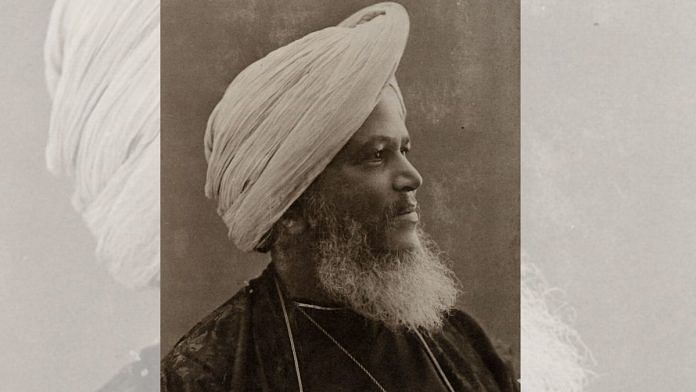One of India’s greatest artists competed for the sixth Nizam of Hyderabad’s attention in 1902. His rival was a photographer of humble origins, and it was his photograph that the Nizam chose over the artist’s masterpiece. The artist was Raja Ravi Varma and his competition was Lala Deen Dayal—India’s first professional photographer to get international renown.
The Nizam, Mahboob Ali Khan, reportedly penned a couplet to honor Deen Dayal: ‘Ajab yeh karte hain tasvir mein kamaal kamaal, Ustaadon ke hain ustaad Raja Deen Dayal’ (In the art of photography, surpassing all, the master of masters is Raja Deen Dayal). He was appointed the official court photographer to the Nizam, who gave Deen Dayal the name ‘Raja Bahadur Mussavir Jung’, which translates to “Brave Warrior of Photography.”
In 1897, he received a Royal Warrant from Queen Victoria.
His black and white photographs offer a glimpse into an elite Colonial India inhabited by Nizams and Maharajas, princes and princesses, sahibs and their wives. His lens captured the opulence of palaces, the wonder of famous monuments and stark landscapes.
“Dayal was master of the medium that would entirely transform how we see and represent the world,” wrote professor Sunil Khilnani in his essay on Deen Dayal in his book, Incarnations: India in 50 Lives.
Also read: Sukumaran went from an English professor to Malayalam cinema’s most outspoken movie star
A royal backing
Lala Deen Dayal, an improbable photographer, was born in 1844 to a family of Jain jewellers in Sardhana, near Meerut. After studying civil engineering and drafting, he started working as a draftsman for the Indore Public Works Department. It was around this time that he started developing an interest in photography.
When photography was first introduced in India in the 1840s, only the wealthy, such as the Maharajas of Jaipur and Benares, could afford to learn and practice the art. Soon after, the first photographic schools and societies were founded in Bombay, Bengal, and Madras in the mid-1850s, and their members were all British colonials.
With the encouragement of the Maharaja of Indore, Shivajirao Hokar, Deen Dayal launched his professional photography career. He is said to have learned the basics while studying to be an engineer. With the patronage of India’s rich, powerful and wealthy class, he was able to establish studios in Indore (around 1874), Secunderabad (around 1886) and Bombay in 1896.
Due to cultural norms prohibiting men from looking at women in public, separate studios were set up for women, called zenana. It is reported that Deen Dayal trained a British woman named Mrs Kenny-Lavick to run the zenana branch of Dayal & Sons studio in Hyderabad.
Deen Dayal was known for his keen business acumen apart from his exceptional photography skills. He was known to offer his clients a guide to better posing for pictures which was titled Hints to Sitters. His studio had around 50 men and one woman employee, historian Manu S. Pillai notes in his article.
His fame only grew after he documented the Prince of Wales (who later became King George V) in India. Deen Dayal also accompanied Sir Lepel Griffin on an 1882 architectural trip of India, helping capture photos for Griffin’s Famous Monuments of Central India, published in 1886.
“Dayal’s body of work is important for both history and art. Without him, we wouldn’t be able to grasp so vividly the period when India was the world’s exotic, marvellous playground for the privileged – before the modern world intervened,” wrote Khilani.
Exhibitions of his work continue to attract large crowds even today while collectors and enthusiasts still seek out his signatures. His studios produced around 30,000 photographs. In 2018, his album on the princes sold for Rs 7 lakh— a testament to his enduring legacy. After his death on 5 July 1905, the charm of his studios seemed to wane.
Also read: Subhas Mukherjee pioneered IVF in India. But the government refuted his work
His legacy, his pictures
In 2006, the Department of Posts under the Ministry of Communications released a commemorative stamp in honour of the pioneering Indian photographer in Andhra Pradesh.
To honour his legacy, the Indira Gandhi National Centre for the Arts (IGNCA) in New Delhi opened a permanent gallery to showcase his works in 2016. The centre also purchased Deen Dayal’s studio collection of 2,857 glass plate negatives in 1989. His famous photos of the 1870s famine are housed in the Peabody Essex Museum in the US and the Alkazi Collection of Photography in New Delhi. But the IGNCA’s collection remains the single largest repository of Deen Dayal’s works.
Author Rupika Chawla in her 2010 book Raja Ravi Varma: Painter of Colonial India writes that for his times, Deen Dayal was no less talented than esteemed painters such as Varma. He “brought to photography what Varma brought to paintings—the pomp and grandeur of kings… with the documentation of places and events.”
His legacy is more than a collection of photos. It is a visual record of India’s history through the lens of India’s first and most celebrated photographer.
(Edited by Ratan Priya)



